Hot glue, the unsung hero of the crafting and DIY world.
With its quick-drying prowess and unparalleled versatility, it’s no wonder that it has become a go-to adhesive for many creative minds. But before you dive headfirst into your next hot glue project, it’s crucial to acknowledge the potential downsides of this sticky wonder.
Because let’s face it, even the most beloved things in life have their flaws. In this blog post, we’ll peel back the curtain and expose the limitations of hot glue.
So gather ’round all you hot glue enthusiasts, as we uncover the not-so-glamorous side of this crafty companion.
Disadvantage of Hot Glue Susceptibility to Temperature Changes
Contents
Hot glue is a versatile adhesive with a quick drying time, making it a popular choice for various projects. However, its susceptibility to temperature changes can pose significant disadvantages in certain situations.
In this blog post, we will delve into the potential issues that arise when hot glue encounters high or low temperatures, as well as the limitations it presents for specific applications and materials.
Softening and Melting in High Temperatures:
When exposed to high temperatures, hot glue softens and melts, causing it to lose its adhesive properties. This can be disastrous if the glued item is placed in a hot environment or comes into contact with heat sources. The once-sturdy bond weakens, leading to damage or breakage. In extreme cases, the glue may even become liquid and drip off the item entirely.
Brittle Bonding in Cold Temperatures:
On the other end of the temperature spectrum, cold temperatures render hot glue brittle and inflexible. Cracks and fractures can form within the glued joints, compromising their strength and durability. This limitation must be considered when using hot glue in freezing environments or for outdoor applications where temperature variations are common.
Expansion and Contraction Stress:
Temperature fluctuations cause hot glue to expand and contract, exerting stress on the bond over time. Frequent temperature changes gradually wear down the adhesive’s integrity, increasing the risk of failure. The expanding and contracting motion weakens the bond’s grip, making it more susceptible to detachment.
Unsuitability for Delicate or Heat-Sensitive Materials:
Hot glue is unsuitable for delicate or heat-sensitive materials such as fabrics or plastics. The high temperatures involved during application can cause irreversible damage or distortion to these materials. When working with such materials, it is crucial to explore alternative adhesives that are less affected by temperature changes.
Long-Term Durability and Maintenance:
Hot glue’s susceptibility to temperature changes can significantly impact its long-term durability and maintenance requirements. Over time, the adhesive properties of hot glue may deteriorate due to temperature variations, resulting in a weaker bond that requires frequent repairs or maintenance. If your project demands longevity and resilience, it is wise to consider alternative adhesives.
Limited Bond Strength
Hot glue, that mesmerizing adhesive with its rapid-drying enchantment, might not be the adhesive superhero we all yearned for. It shines brightly but has its boundaries, my dear friends. Allow me to elaborate.
Foremost and above all, hot glue possesses a limited bond strength. It’s akin to attempting to support a colossal boulder with a mere toothpick – it simply won’t suffice. While hot glue can perform miracles on porous surfaces like fabric, wood, or paper, it grapples with adhering to smooth or non-porous surfaces like metal or glass. So, if you’re contemplating gluing that lustrous metal sculpture together, think twice before reaching for the hot glue gun.
But hold on, there’s more. Hot glue’s limited bond strength implies that it may not withstand heavy loads or stress. Picture employing hot glue to secure a weighty object – it may endure for a short time, but eventually, it could easily detach and leave your project in ruins. And don’t even get me started on extreme temperatures. Hot glue joints cannot handle the heat (quite literally). When exposed to high temperatures, the glue softens and forfeits its adhesive properties faster than ice cream melts on a scorching summer day.
And here’s another kicker – hot glue is not precisely the forever kind of adhesive. It’s more of a temporary fling. While this may be beneficial in certain cases where temporary bonding is required, it’s far from ideal if you seek a long-lasting and sturdy bond. Contemplate it – do you genuinely desire your meticulously crafted masterpiece falling apart after a few months?
Oh, and did I mention that hot glue doesn’t fare well with the great outdoors? No sir, it favors the snug confines of indoor projects. Sunlight and moisture act like kryptonite to hot glue – they degrade its adhesive properties faster than you can utter “sticky situation.”
Lack of Flexibility
The lack of flexibility in hot glue can have significant implications in various applications. Understanding these implications is crucial for choosing the right adhesive for specific projects. Let’s take a closer look at the consequences of hot glue’s rigidity and explore alternative options that offer better flexibility.
Firstly, when hot glue dries, it becomes rigid and hard, making it unable to stretch or bend with the materials it’s adhered to. This can be problematic when bonding two pieces of fabric together. While hot glue may initially hold the fabric pieces in place, the lack of flexibility can cause tearing or ripping when the fabric is stretched. This limitation is certainly not ideal for DIY fashion projects or any applications involving movement.
Furthermore, hot glue’s inflexibility makes it less suitable for wearable items like clothing or accessories. The stiff nature of the adhesive restricts movement and comfort, leaving you feeling more like a medieval knight than a stylish trendsetter. To achieve flexibility in wearable projects, alternative adhesives such as flexible fabric glues should be considered.
The lack of flexibility in hot glue also affects its bond strength on certain surfaces. When trying to stick two pieces of plastic together with hot glue, the rigid adhesive often results in a weak bond that easily breaks under stress or pressure. For sturdy connections in applications involving plastic or other materials prone to movement or expansion, specialized adhesives designed for flexibility should be used instead.
Additionally, removing hot glue once it’s applied can be a challenge due to its rigidity. Removing the adhesive without damaging the objects or surfaces involved requires extra care and effort. This drawback can be avoided by choosing adhesives that offer easier removal options.
Despite its limitations, hot glue still has its strengths. Its quick-drying properties and strong initial bond make it ideal for crafts and DIY projects that don’t require movement or a high degree of flexibility.
Potential for Burns and Injuries
Crafting with hot glue can be a fun and rewarding activity, but it’s essential to be aware of the potential risks involved. In this article, we will explore the dangers of burns and injuries that can occur when using hot glue. By understanding these risks and taking necessary precautions, you can ensure a safe crafting experience.

Burns – A Risk Not to Be Ignored:
Hot glue is no joke when it comes to heat. This adhesive is heated to scorching temperatures, making accidental contact with the skin a serious concern. The severity of burns can range from minor blisters to severe wounds, depending on the duration of contact and the amount of glue involved. Hot glue guns pose an even greater risk due to their manual handling, which can lead to spills or drips.
Unexpected Injuries – Beware the Bursting Glue:
Don’t underestimate the power of pressure. Applying excessive force on the glue gun can cause the adhesive to burst out unexpectedly. This can result in hot glue splattering onto your skin or, worse, into your eyes. The excruciating pain and potential damage make it crucial to handle the glue gun with care.
Toxic Fumes – A Hidden Danger:
While hot glue may seem harmless, some types emit toxic fumes that can be harmful if inhaled excessively or over an extended period. Protect your respiratory system by working in well-ventilated areas or considering the use of a protective mask. Don’t let invisible threats compromise your health.
Safety Precautions – Your Shield Against Accidents:
To shield yourself from burns and injuries, follow these safety precautions:
- Wear protective gloves and goggles, especially when handling larger amounts of hot glue or operating a hot glue gun.
- Keep a first aid kit nearby and know how to treat minor burns promptly.
- Educate children about the potential dangers of hot glue and closely supervise them during crafting activities.
Limited Compatibility with Certain Materials
It’s important to recognize that hot glue does have limitations when it comes to compatibility with certain materials. In this article, we will delve into the reasons why hot glue may not be suitable for all materials and applications, offering valuable insights to ensure successful project outcomes.
Compatibility Issues:

Plastic and Metal:
Hot glue may struggle to adhere to certain plastics or metals due to their high melting points or smooth surfaces. These materials pose a challenge for hot glue, preventing it from forming a strong bond. To overcome this limitation, consider alternative adhesives such as epoxy or super glue, which are better suited for bonding these materials.
Testing Compatibility:
Before committing to hot glue extensively, it’s crucial to conduct compatibility tests by applying a small amount of glue to a test area. This way, you can assess whether the bond is satisfactory or if you need to explore alternative adhesives that are more compatible with your specific material.
Craft Applications:
Heat-Sensitive Materials:
When working with delicate materials like foam or fabric, the high temperature of hot glue can cause damage or melting. To avoid compromising your craft materials, opt for cold adhesives like fabric glue or adhesive sprays that provide a secure bond without subjecting your materials to excessive heat.
Long-Term and Outdoor Applications:
Temperature Sensitivity:
Hot glue may not be ideal for long-term or outdoor applications due to its susceptibility to extreme temperatures. When exposed to high heat, the adhesive can soften or become brittle, leading to bond failure. Instead, consider adhesives formulated specifically for outdoor use or with higher temperature resistance.
Inadequate Waterproof Properties
Hot glue has gained popularity as a go-to adhesive for various craft and DIY projects due to its versatility and strong bonding properties. However, when it comes to waterproofing or resisting moisture, hot glue falls short. In this article, we will explore why hot glue is not the best option for applications that require effective waterproofing or moisture resistance.
Inadequate Waterproof Properties:
Softening and Melting:
Hot glue is not designed to withstand exposure to water or high humidity. When it encounters moisture, it can soften or even melt, compromising the integrity of the bond. Imagine spending hours creating a beautiful outdoor project, only to have it fall apart after the first rain shower.
Dissolution:
Unlike adhesives specifically formulated to be water-resistant or waterproof, hot glue can dissolve completely when exposed to liquids. This major drawback renders it unsuitable for applications that involve regular contact with water, such as bathroom fixtures or items that may be submerged.
Unsuitability for Wet Environments:
Hot glue should not be used in wet environments as it cannot provide a long-lasting and secure bond under these conditions. Whether it’s a boat repair or an outdoor fountain project, hot glue simply cannot endure constant moisture.
Consider Alternative Adhesives:
When choosing an adhesive for waterproof applications, it is crucial to consider the intended use and environment. Epoxy or specialized outdoor adhesives are great alternatives that offer superior waterproofing properties and can reliably seal against moisture.
Alternatives to Hot Glue
In this blog post, we will explore a range of options that offer stronger bonds, better durability, and even resistance to water. From epoxy adhesive to double-sided tape, we’ve got you covered with a variety of alternatives that will take your DIY adventures to the next level. Let’s dive into the world of hot glue alternatives and discover the perfect adhesive for your next crafting endeavor.
Epoxy Adhesive:
For a strong and durable bond, epoxy adhesive is your go-to alternative. Its two-part formulation – resin and hardener – offers excellent bonding capabilities on materials like wood, metal, and plastic. Withstanding heavy loads and harsh conditions, epoxy is ideal for projects that require long-lasting strength.
Double-Sided Tape:
When you need quick and easy bonding without tools or equipment, double-sided tape is a fantastic option. Perfect for attaching lightweight objects such as paper or decorations to surfaces, it may not be as effective for heavier items or materials with uneven surfaces.
Liquid Nails or Construction Adhesive:
If you’re tackling construction projects or need a more permanent bond, liquid nails or construction adhesive is the way to go. This versatile adhesive can be applied to various surfaces like wood, metal, concrete, and ceramics. Although it may require a longer curing time compared to hot glue, the results are worth it – a strong and durable bond that stands the test of time.
Craft Glue or White Glue:
For delicate projects or heat-sensitive materials, craft glue or white glue is an excellent alternative. Drying clear and effective at bonding lightweight materials, it may require clamping or holding objects together until the adhesive sets.
Sewing or Stitching:
When flexibility and a secure bond are essential, sewing or stitching is an alternative method of joining fabrics and materials. Although more time-consuming than hot glue, sewing provides a stronger and more durable attachment.
Tips for Safe Use of Hot Glue
Hot glue is a versatile adhesive that can be used for a variety of crafts and projects. However, it’s essential to handle hot glue with caution to prevent accidents or injuries. By following these safety precautions and guidelines, you can ensure that your hot glue experience is both enjoyable and safe.
Protect Your Hands:
When working with hot glue, always wear heat-resistant gloves or finger guards. These protective gear will shield your hands from burns and blisters. Remember that hot glue can reach high temperatures, so avoid direct contact with the glue or any recently glued surfaces.
Find a Safe Spot:
Set up your crafting area on a heat-resistant surface, such as a silicone mat or aluminum foil. This will protect your workspace from heat damage and make cleanup easier. Additionally, ensure that you work in a well-ventilated area to prevent inhaling any fumes that may be emitted during the gluing process.
Keep It Out of Reach:
Hot glue is not only sticky but also hot. Keep it away from young children and pets to avoid accidents. Store your hot glue gun and glue sticks in a safe place where they cannot be accessed by curious hands or playful paws. This will help prevent any unintended burns or misuse.
Cool Down Before You Move:
After completing your gluing project, allow the hot glue to cool down and harden before handling it. Touching hot glue immediately after application can cause serious burns. Be patient and give it time to cool off completely before moving or manipulating your creation.
Aim Away from Yourself:
When dispensing the hot glue, always point the nozzle away from yourself and others. This precaution prevents accidental burns or injuries. Use controlled movements to apply the glue precisely where you want it, avoiding excessive force that can cause splattering or unexpected discharges.
UBIHBYJI6Wc” >
Also Read: Is Hot Glue Conductive?
Conclusion
In conclusion, hot glue may be a go-to adhesive for crafting and DIY enthusiasts, but it’s not without its drawbacks. One major downside is its vulnerability to temperature fluctuations. When faced with high heat, hot glue can soften and melt, resulting in weakened bonds and potential damage or breakage. On the flip side, in cold temperatures, this adhesive becomes rigid and brittle, compromising the strength and durability of any project.
Another limitation of hot glue lies in its bond strength, particularly on smooth or non-porous surfaces like metal or glass. It simply may not hold up under heavy loads or stress, making it unsuitable for applications that require long-term durability.
Flexibility is also an issue when it comes to dried hot glue. This rigidity can pose problems for projects involving movement or stretching. Fabrics may tear or rip when subjected to hot glue, while wearable items may sacrifice comfort due to the lack of flexibility.
Safety is another concern associated with hot glue usage. Mishandling or accidental contact can result in painful burns. Additionally, certain types of hot glue emit toxic fumes that can be harmful if excessively inhaled.
Furthermore, hot glue has compatibility issues with certain materials and fails to provide adequate waterproofing or moisture resistance.
Despite these disadvantages, there are alternative adhesives available that offer stronger bonds, improved durability, flexibility, and water resistance. Epoxy adhesive, double-sided tape, liquid nails or construction adhesive, craft glue or white glue, sewing or stitching are all viable options depending on your specific project requirements.
To ensure a safe crafting experience with hot glue, it’s crucial to adhere to safety precautions such as wearing protective gear like gloves and goggles. Working in a well-ventilated area is essential to minimize exposure to toxic fumes. Keep hot glue out of reach of children and pets at all times. Allow it ample time to cool down before handling it and always aim away from yourself when dispensing the adhesive.






